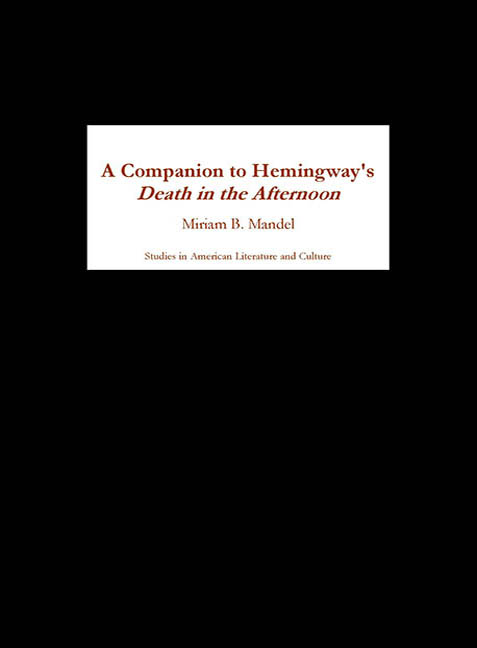Book contents
- Frontmatter
- Dedication
- Contents
- Acknowledgments
- Hemingway Works That Address the Bullfight
- A Note on the Text of Death in the Afternoon
- Introduction
- Composition, Sources, and Backgrounds
- The Composition, Revision, Publication, and Reception of Death in the Afternoon
- “Devout Again by Cynicism”: Lord Byron and Don Juan in Death in the Afternoon
- “I like you less and less”: The Stein Subtext in Death in the Afternoon
- Subject and Author: The Literary Backgrounds of Death in the Afternoon
- Reading Texts, Paratexts, and Absence
- On Authorship and Art
- And What Came After
- Works Cited
- Notes on the Contributors
- Index
The Composition, Revision, Publication, and Reception of Death in the Afternoon
from Composition, Sources, and Backgrounds
Published online by Cambridge University Press: 27 April 2017
- Frontmatter
- Dedication
- Contents
- Acknowledgments
- Hemingway Works That Address the Bullfight
- A Note on the Text of Death in the Afternoon
- Introduction
- Composition, Sources, and Backgrounds
- The Composition, Revision, Publication, and Reception of Death in the Afternoon
- “Devout Again by Cynicism”: Lord Byron and Don Juan in Death in the Afternoon
- “I like you less and less”: The Stein Subtext in Death in the Afternoon
- Subject and Author: The Literary Backgrounds of Death in the Afternoon
- Reading Texts, Paratexts, and Absence
- On Authorship and Art
- And What Came After
- Works Cited
- Notes on the Contributors
- Index
Summary
After publishingA Farewell to Armsin 1929, Ernest Hemingway turned his attention almost wholly to nonfiction. While he did write several short stories and supervised (to a limited extent) the 1930 republication of In Our Time, from 1930 to 1932 his attention and interest were focused almost entirely on the long treatise on bullfighting that would eventually be titled Death in the Afternoon. By the time the book was published, however, it had expanded beyond its original focus on bulls and bullfighters: Death in the Afternoon was Hemingway's first and most complete essay on art and his first public articulation of his opinions on writers and writing. He worked harder on Death in the Afternoon then he had worked or would work on any book published in his lifetime. Death in the Afternoon, therefore, deserves special attention for what it shows of Hemingway's views on art as well as what it shows of the way his publisher, Charles Scribner's Sons, handled what was until then an atypical book for one of its star fiction writers to produce.
Writing a guide to bullfighting had been a dream of Hemingway's at least since 1925. In his first letter to Maxwell Perkins (his editor at Scribner's), dated 15 April 1925, Hemingway had written, “I hope some day to have a sort of Doughty's Arabia Deserta of the Bull Ring, a very big book with some wonderful pictures” (qtd. in Bruccoli, 34). His interest was revived in November 1929 when his friend, the poet Archibald MacLeish, asked him to contribute an article on bullfighting as an industry to Fortune, a new magazine owned by Henry Luce; MacLeish had taken an editorial job with the business magazine, which agreed to pay Hemingway $1,000 for the 2,500-word article (Baker, 205–6). The article, titled “Bullfighting, Sport and Industry,” appeared in the March 1930 issue. Focused almost exclusively on bullfighting as a business, the article addressed the economic plights and rewards for the promoters, bull breeders, and bullfighters, and bore little resemblance to Death in the Afternoon.
- Type
- Chapter
- Information
- A Companion to Hemingway's Death in the Afternoon , pp. 21 - 42Publisher: Boydell & BrewerPrint publication year: 2004

